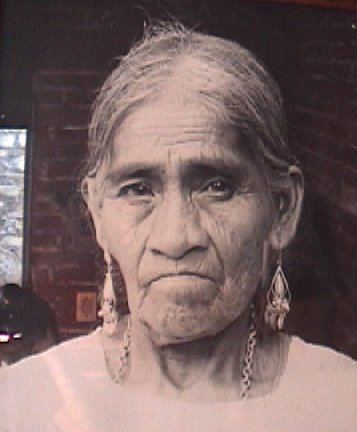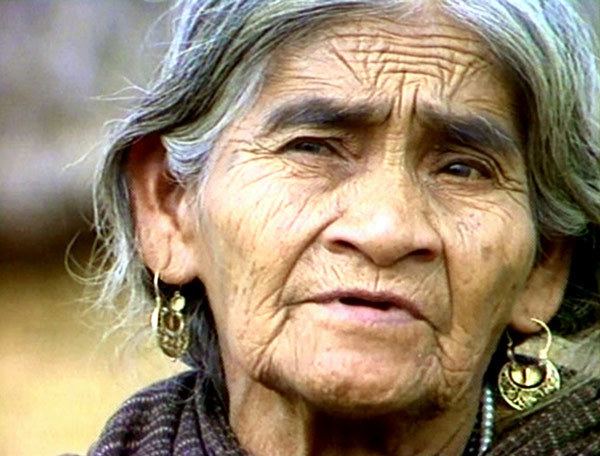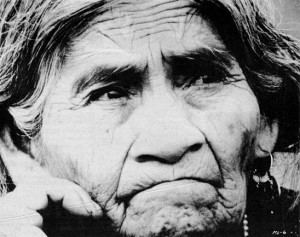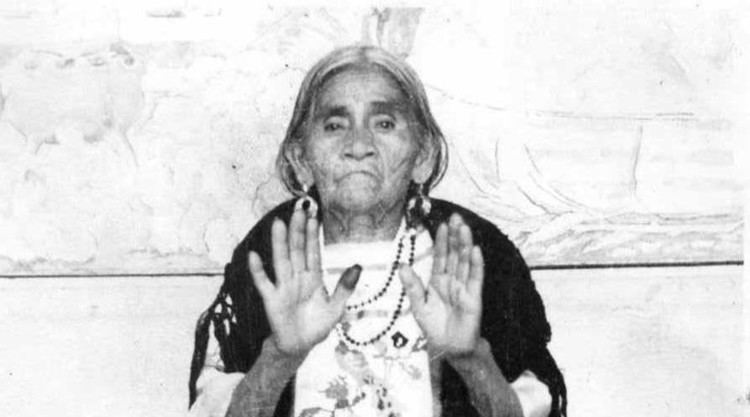Name Maria Sabina | ||
 | ||
Mar a sabina curandera famosa en el mundo
María Sabina (July 22, 1894 – November 23, 1985) was a Mazatec curandera who lived in the Sierra Mazateca of southern Mexico. Her practice was based on the use of psilocybin mushrooms, such as Psilocybe mexicana.
Contents
- Mar a sabina curandera famosa en el mundo
- MARIA SABINA SENTIMIENTO MAZATECO
- Life
- Use of synthetic entheogens
- Chants
- Cultural impact
- Songs
- References

MARIA SABINA-SENTIMIENTO MAZATECO
Life

María Sabina was born outside of Huautla de Jimenez in the Sierra Mazateca toward the end of the 19th century. Though Sabina herself was not sure, she believed it to be 1894. Her parents were both humble campesinos, mother María Concepcion and Crisanto Feliciano, her father, who died from an illness when she was three years old. She also had a younger sister, María Ana. Her grandfather and great-grandfather on her father's side were also shamen, skilled in using the mushrooms to communicate with God. After the death of her father, her mother moved the family into town, and Sabina grew up in the house of her maternal grandparents.

María Sabina was the first contemporary Mexican curandera, or native shaman, to allow Westerners to participate in the healing vigil that is known as the velada. All participants in the ritual ingested psilocybin mushroom as a sacrament to open the gates of the mind. The velada is seen as a purification and a communion with the sacred.

In 1955, the US ethnomycologist and banker R. Gordon Wasson visited María Sabina's hometown and participated in a velada with her. He collected spores of the fungus, which he identified as Psilocybe mexicana, and took them to Paris. The fungus was cultivated in Europe and its primary ingredient, psilocybin, was isolated in the laboratory by Swiss chemist Albert Hofmann in 1958.

Youth from the United States began seeking out María Sabina and the "magic" mushrooms as early as 1962. In the years that followed, thousands of counterculture mushroom seekers, scientists, and others arrived in the Sierra Mazateca to seek an audience. By 1967 more than 70 people from the US, Canada, and Western Europe were renting cabins in neighboring villages. Many of them went there directly after reading "Seeking the Magic Mushroom", a 1957 Life magazine article written by Wasson about his experiences.

María Sabina received several of them, including Wasson, who became a friend. Many 1960s celebrities were rumored to have visited Sabina, including rock stars such as Bob Dylan, John Lennon, Mick Jagger and Keith Richards.

While she was initially hospitable to the first of the arrivals, their lack of respect for the sacred and traditional purposes caused María Sabina to remark:
"Before Wasson, nobody took the children simply to find God. They were always taken to cure the sick."
As the community was besieged by Westerners wanting to experience the mushroom-induced hallucinations, Sabina attracted attention from the Mexican police who believed her to be a drug dealer. The unwanted attention completely altered the social dynamics of the Mazatec community and threatened to terminate the Mazatec custom. The community blamed Sabina, she was ostracized from her community and her house was razed. Sabina later regretted having introduced Wasson to the practice, but Wasson contended that his only intention was to contribute to the sum of human knowledge.
Late in life, María Sabina became bitter about her many misfortunes, and how others had profited from her name. She also felt that the ceremony of the velada had been irredeemably desecrated and polluted by the hedonistic use of the mushrooms:
"From the moment the foreigners arrived, the 'holy children' lost their purity. They lost their force, they ruined them. Henceforth they will no longer work. There is no remedy for it."
Use of synthetic entheogens
In 1962, R. Gordon Wasson and Albert Hofmann went to Mexico to visit María Sabina. They brought a bottle of psilocybin pills, Hoffman's latest invention. Sandoz was marketing them under the brand name Indocybin—"indo" for both Indian and indole (the nucleus of their chemical structures) and "cybin" for the main molecular constituent, psilocybin. Hofmann gave his synthesized entheogen to the curandera. "Of course, Wasson recalled, Albert Hofmann is so conservative he always gives too little a dose, and it didn't have any effect." Hofmann had a different interpretation: "activation of the pills, which must dissolve in the stomach, takes place after 30 to 45 minutes. In contrast, the mushrooms when chewed, work faster as the drug is absorbed immediately". To settle her doubts about the pills, more were distributed. In total, for Maria, her daughter, and the shaman Don Aurelio up to 30 mg. each was ingested, a moderately high dose by current standards but not perhaps by the more experienced practicioners. At dawn, their Mazatec interpreter reported that Maria Sabina felt there was little difference between the pills and the mushrooms. She thanked Hofmann for the bottle of pills, saying that she would now be able to serve people even when no mushrooms were available.
Chants
Álvaro Estrada, a fellow Mazatec, recorded her life and work and translated her chants. Estrada's American brother-in-law, Henry Munn, translated many of the chants from Spanish to English, and wrote about the significance of her language. According to Munn, María Sabina brilliantly used themes common to Mazatec and Mesoamerican spiritual traditions, but at the same time was a unique talent, a masterful oral poet, and craftsperson with a profound literary and personal charisma.
It is sung in a shamanic trance in which, as she recounted, the "saint children" speak through her:
Cultural impact
Sabina is regarded as a sacred figure in Huautla. At the same time, her image is used to market various local commercial ventures, from restaurants to taxi companies.
The Mexican counterculture has an affinity for Sabina. The Mexican rock group Santa Sabina is named for her, and El Tri, one of the first and most successful rock groups in Mexico, dedicated the song "María Sabina" to her, proclaiming her "un símbolo de la sabiduría y el amor" ("a symbol of wisdom and love").
Mexican musician, Jorge Reyes, included prerecorded chants of Maria Sabina in the track "The Goddess of the Eagles", in his album Comala. Reyes also used more of the recording in his collaboration with "Deep Forest" on the track, "Tres Marias", in the Album "Comparsa".
Bolivian singer Luzmila Carpio has made a song in honor of Maria Sabina.
Songs
Soft singing
Chjon nka
Don't be concerned - old one
